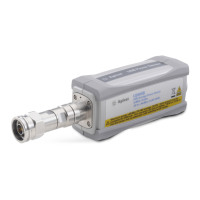3 Specifications and Characteristics
48 U2000 Series Operating and Service Guide
Power Accuracy
This specification is valid only after zeroing and calibration of the power
sensor at ambient environmental conditions.
Table 3-1 Average only Mode Power Accuracy
1
(with exclusions)
Table 3-2 Normal Mode Power Accuracy
1,2
(with exclusions)
With conditions as follows:
• After zeroing
3
and 30 minutes of power- on warm- up
• Number of averages = 1024
Model Power Level
Accuracy
25 °C ±10 °C
Accuracy
0 °C to 55 °C
U2000/1/2/4A –60 dBm to +20 dBm ±3.0% ±3.5%
U2000/1/2H –50 dBm to +30 dBm ±4.0% ±5.0%
U2000/1B –30 dBm to +44 dBm ±3.5% ±4.0%
1 The accuracy is essentially a combination of linearity, instrumentation accuracy, and traceability to
absolute accuracy at 50 MHz, 0 dBm. Note: mismatch uncertainty, cal-factor uncertainty, and
power level dependent terms (zero set, drift, and noise) are excluded in this specification and
specified elsewhere in this guide.
Model Power Level
Accuracy
25 °C ±10 °C
U2000/1/2A –30 dBm to +20 dBm
±
4.0%
U2000/1/2H –20 dBm to +30 dBm
±
5.0%
U2000/1B 0 dBm to +44 dBm
±
4.5%
2 The accuracy for –7 dBm to +1 dBm (U2000/1/2A), +3 dBm to +11 dBm (U2000/1/2H), and +23
dBm to +31 dBm (U2000/1B) power level will be dominated by zero set and measurement noise.
For overall accuracy, refer to the measurement uncertainty calculator which is available on the
Agilent Technologies Web site.
3 It is strongly advisable to perform external zeroing on the U2000 Series USB power sensor for
power measurement level below –30 dBm (U2000/1/2A), –20 dBm (U2000/1/2H), and 0 dBm
(U2000/1B) for accurate measurements. During the external zeroing process, the RF input signal
must be switched off or the device-under-test disconnected from the U2000 Series USB
power sensor.

